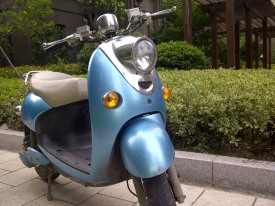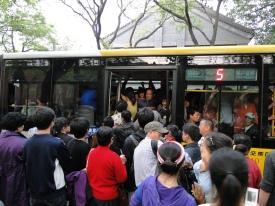 As I speed around Chinese cities everyday on my scooter going to wherever I need to go, I’m constantly fighting back the anger flames from bursting out of my ears. The stereotype of Chinese being terrible drivers is no joke; they shouldn’t be allowed behind the wheel. Ever.
As I speed around Chinese cities everyday on my scooter going to wherever I need to go, I’m constantly fighting back the anger flames from bursting out of my ears. The stereotype of Chinese being terrible drivers is no joke; they shouldn’t be allowed behind the wheel. Ever.
But then the always contesting voice in my head pushes back, thinking, there must be a reason why they drive as they do.
So, I throw the question out to see what might come back: “China, why do you suck at driving?”
Five years ago, the test you needed to pass in order to obtain your driver’s license was a joke. Studying consisted of looking over a book just before the exam and waltzing in as if you owned the place.
Today the test is a bit more difficult. So difficult that my friend, who already holds a license in Europe, failed the first time. The questions are hard, asking for precise answers, and they allow few mistakes. But here’s where they’re dropping the ball: when being tested on your practical skills, you drive in a controlled space around some strategically placed cones.
After hearing this, I physically had to use both hands to pick my jaw up off the floor and asked my student, who speaks flawless English, to please repeat what he had just said, to make sure I hadn’t misheard.
And he repeats: “in China you are required to pass a written exam on a computer and then you are required to drive. There is one test person in the car with you. And one outside the car.”
“Wait…one person outside the car? Why? Where are you…” I suddenly realize: “Oh no , you’re driving in a controlled space, aren’t you?”
“Yes, of course. It’s too dangerous to drive on the road in traffic,” he curtly responds.
“In my opinion,” I say calmly, but firmly, “wouldn’t it be more beneficial to drive on the road, with the other cars, where you will be driving as soon as you receive your drivers permit” ? Even a small child could drive in an enclosed area with a few cones and no cars.
From what my student told me, they are required to drive, forward, backward, and maybe they have to turn around. Without any other cars around, I can only assume they never have to learn how to park.
This explains why everyone in the car has to get out to guide the driver when they need to park.
Also, because cars are so new in China, they are learning the theory from a book which includes traffic laws about signs and red lights; but it doesn’t include things about what you should do when you have a car accident (i.e. get out of the way of oncoming traffic), or that you should pull over when verifying where you’re going (and not just stop in the middle of the road), or, the most important, who has the right-away at intersections.
Although these explanations for their poor driving are legitimate, it didn’t suffice. I didn’t believe this was the only reason they were such poor drivers.
Then it came to me. I didn’t learn how to drive from my driver’s education course in high school or from studying the test manual prior to the exam. I learned how to drive from the backseat of my parent’s car for the first 14 years of my life. The common sense and decision making skills linked to driving simply came from my years of observation. When driving, watching the mistakes people are making, I don’t know better because I studied a manual. I know better because I’ve been in a car my entire life. I “studied” the art of driving for many years. Of course I still made mistakes when I took the wheel, but I most certainly had to learn much less from personal experience.
The Chinese don’t have this life experience. People are much more wealthy today in China than they used to be and more and more average citizens are able to afford cars each year. Parents are now able to help sons and daughters buy a car when they have never even had one themselves.
So, where do these new drivers learn how to drive? They learn from observation, on the road, from their own mistakes. Essentially, they are learning how to drive from other drivers who have also not been properly educated.
Currently, no permit or helmet is required to drive a scooter. This may be the most concerning of all. The only people driving
scooters in China are low-class Chinese whose salaries are very low each month, and foreigners. These scooters are often the most dangerous of all. Traffic laws are never followed and traffic lights are not honored (red, green, yellow, blue, it’s all the same to these guys).
Now, my experience with driving is only from the outside. I’ve never driven a car in China nor do I ever desire to. I just ride in taxis and buses and constantly swerve around the cars on my scooter. Other than the taxis and buses driving quite fast, sometimes through red lights, never using turn signals, cramming themselves full to capacity (see left) and absolutely never yielding to pedestrians, I almost always feel safe.
In 2004, 94,000 people died from road injuries. Only 65,387 people died in 2011. This number is dropping, which gives me hope; but, the population of China must be taken into consideration. Currently, for every 100,000 drivers in China, there are 27.8 road fatalities per year. In the US, only 14.9.*
My only hope is that the small children in the backseats are paying attention. I hope they realize its quite dangerous to walk outside, in China. I hope that the Chinese begin to figure out these seemingly obvious issues. And most importantly, I hope that I can return to China in 20-30 years to find a dramatically safer environment.
Below I’ve attached a video from YouTube that is quite famous. Although incredible, I’m not posting this video for this Chinese man’s sweet moves. Take a look at everyone’s reaction to the accident. Then, in the end, the bike owner, able to walk away, makes a decision that immediately forces me to droop my head and sigh: “Oh…China, China, China”.
*Information for the statistics above can be found here.
Other stories you might like:



